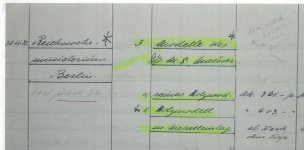R.W. Parker
Well-known member
I was again perusing Jim's opening treatise in this stickied thread from ten years ago...
<Evidence that the War Office was involved in the proliferation of the Mauser Deutches Sportmodell is noted in the order/offer records recently brought to light in Jon Speed’s “Mauser Archive” Wooden and aluminum models were procured by the German Military in November 1933. In is interesting in this reference that the entire records for 1934 were omitted and likely were destroyed as they would have contained significant evidence that Germany was in fact rearming in violation of the Treaty of Versailles and no doubt tooling, blueprints and drawings for the DSM 34 would have been noted going to the 16 firms that ultimately produced the guns at the direction of the new NAZI government....
To sort that out, one must consider the above and look to period literature. The manufacturers catalogs and prospectus aid to a great extent. Here too, though, the issue remains cloudy as even the “standardized” Deutches Sportmodell and Klein Kaliber Wehrsport Gewehr were proofed commercially and sold by retail firms to suppress suspicion and camouflage the Third Reich’s very active re-armament and marksmanship programs subsequent to 1933.>
...and was wondering: If the Versailles Treaty specifically omitted prohibitions on the manufacture of caliber .22 rimfire rifles (in other words "Make all you want, we don't care!"), wouldn't a similar attitude regarding the styling of those rifles and the manner in which they were implemented logically follow? That is to say, if the Allied inspectors were satisfied that the Treaty was being adhered to, why would the Allies care if the style of sport shooting in Germany began to resemble a military training exercise or a church picnic?
Very obviously DSMs and KKWs were made to look like a commercial product, and even offered for export. What fascinates me, however, is why there would be sufficient paranoia to omit/destroy those 1934 records if rimfire rifles were a non-prohibited item. Surely such action must've been taken for reasons other than concealing the manufacture of .22 trainers.
Admittedly, I'm not familiar with the Versailles' Treaty finer points. Would the violation have been the involvement of the War Office in the development of these military-styled models? My understanding was that Germany could've had as many men under arms as she wanted, so long as their rifles were chambered for .22LR.
Richie
<Evidence that the War Office was involved in the proliferation of the Mauser Deutches Sportmodell is noted in the order/offer records recently brought to light in Jon Speed’s “Mauser Archive” Wooden and aluminum models were procured by the German Military in November 1933. In is interesting in this reference that the entire records for 1934 were omitted and likely were destroyed as they would have contained significant evidence that Germany was in fact rearming in violation of the Treaty of Versailles and no doubt tooling, blueprints and drawings for the DSM 34 would have been noted going to the 16 firms that ultimately produced the guns at the direction of the new NAZI government....
To sort that out, one must consider the above and look to period literature. The manufacturers catalogs and prospectus aid to a great extent. Here too, though, the issue remains cloudy as even the “standardized” Deutches Sportmodell and Klein Kaliber Wehrsport Gewehr were proofed commercially and sold by retail firms to suppress suspicion and camouflage the Third Reich’s very active re-armament and marksmanship programs subsequent to 1933.>
...and was wondering: If the Versailles Treaty specifically omitted prohibitions on the manufacture of caliber .22 rimfire rifles (in other words "Make all you want, we don't care!"), wouldn't a similar attitude regarding the styling of those rifles and the manner in which they were implemented logically follow? That is to say, if the Allied inspectors were satisfied that the Treaty was being adhered to, why would the Allies care if the style of sport shooting in Germany began to resemble a military training exercise or a church picnic?
Very obviously DSMs and KKWs were made to look like a commercial product, and even offered for export. What fascinates me, however, is why there would be sufficient paranoia to omit/destroy those 1934 records if rimfire rifles were a non-prohibited item. Surely such action must've been taken for reasons other than concealing the manufacture of .22 trainers.
Admittedly, I'm not familiar with the Versailles' Treaty finer points. Would the violation have been the involvement of the War Office in the development of these military-styled models? My understanding was that Germany could've had as many men under arms as she wanted, so long as their rifles were chambered for .22LR.
Richie




